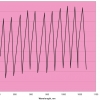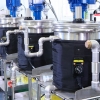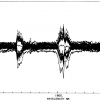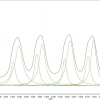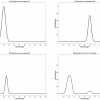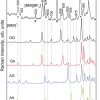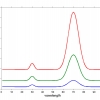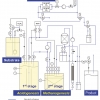Tony (A.M.C.) Davies is again telling us to “Always look at the spectrum”. This time he uses an example from the development of a NIR spectrometer to demonstrate that one doesn’t really know what’s going on until one has “looked at the spectrum”.
Tony Davies Columns
Pages
Anaerobic digestion is a good solution to the joint problems of dealing with organic waste and producing “clean” energy. However, running the digesters at optimum performace is a complex business. NIR spectroscopy offers a solution to monitor a number of analytes within the reactor and in real time.
Tony (A.M.C.) Davies stresses the importance of always looking at the spectrum, even if you [think you] know there’s nothing to learn. He relates his experience with noise in NIR spectra and what he has learnt from it. He would like us all to examine spectra for abnormality before relying on automated methods.
1H NMR spectra are usually interpreted by hand, which is very time consuming, and can become a process bottleneck in fields such as high-throughput NMR. Greater automation of the spectral analysis process has become essential if NMR is to be of value as a high-throughput analytical method in the future.
Tony Davies and Tom Fearn present “A digression on regression”. They turn their attention to one of the simpler regression techniques, Classical Least Squares (CLS). As well as an explanation of the basics, they explain why it is not often used in spectroscopy, and give the pros and cons of various regression techniques.
Time for a good whinge (“complain persistently and in a peevish or irritating way”—Oxford Dictionaries Online) and to get a little controversial. Having had a year to look at the resources available to us to help educate our budding spectroscopists, I have been disappointed that much of the educational resources available online appear incomplete or outdated. For a generation of students brought up in schools with interactive whiteboards, good quality spectroscopic teaching materials of this nature are almost non-existent.
I recently “discovered” a very interesting radio programme on BBC Radio 4. It is “devoted to the powerful, sometimes beautiful, often abused but ever ubiquitous world of numbers”. A few weeks ago we were asked to say what we were doing while listening to the programme. The next week we were told that nearly 2000 e-mails had been received and this data had been given to information designer David McCandless to turn into a graphic. When this was trailed I got the impression that something new and exciting was going to be displayed and I thought that the graphic would...
Analytical Information Mark-up Language, better known as AnIML, has been around as a concept for a number of years, but how does an analytical chemist use it in the real lab? A team of R&D scientists at LGC has been finding out.
<p>In last year’s <a href="https://www.spectroscopyeurope.com/td-column/and-now-something-completel...">August/September</a> issue of <em>Spectroscopy Europe</em> I wrote a column about my “discovery” of computational chemistry and asked if anyone was interested. A satisfying number of readers answered the on-line survey with very positive comments but none more so than Patrik Johansson who e-mailed me about his delight with the column and to...
Christmas is a time of giving and it is with great pleasure that we are able to report the news that Dr Michael Heise, a friend of many years both personally and of this column, has recently been awarded the title of Honorary Professor at the University of Applied Sciences of South-Westphalia in Iserlohn, Germany.1 Mike has been regarded for a long time as an “Internationaler Experte für Infrarot-Spektroskopie”, as the Iserlohn University of Applied Sciences put it on their press release!
This column has been developed from two recent publications by Tom Fearn. "The effect of spectral pre-treatments on interpretation” and "On the geometry of SNV and MSC"
A.N. Davies,a H.M. Heiseb and D.F. Ihrigc
aProfessor, SERC, University of Glamorgan, UK, Director, ALIS Ltd, and ALIS GmbH—Analytical Laboratory Informatics Solutions
bISAS—Institute for Analytical Sciences at Dortmund University of Technology, Bunsen-Kirchhoff-Str. 11, D-44139 Dortmund, Germany
cUniversity of Applied Sciences of South-Westphalia, Frauenstuhlweg 31, D-58644 Iserlohn, Germany
This column is about “Computational Chemistry”.
The definition of Chemometrics is: “The application of mathematical and statistical techniques to extract information from complex data”. You might think that it is computational chemistry, but I suspect that the majority of people who use computational chemistry have little knowledge or interest in chemometrics and similarly most chemometricians have little interest in computational chemistry. Computational chemistry uses the results of theoretical chemistry, incorporated into efficient computer programs, to...
I would like to thank everybody who has taken the trouble to respond to my last column on Educating Spectroscopists.1 I am very happy that Ian has allowed me space to reproduce some of them in this edition.
In the previous version of this column, Tony Davies (the younger) was being controversial about education and in this issue, I am being controversial about one of the current applications of chemometrics to the use of spectroscopy in industry.
Now maybe I’m going to be a little controversial in this month’s column and I might just touch a nerve in the readership. If you are of a nervous disposition or are easily upset, this column may damage your health! However, I can’t stop worrying about the miss-match between what we teach undergraduate students about spectroscopy and what they will be expected to understand about our subject when they finally end up in gainful employment.
In our previous column we introduced CVA, one of the very early applications of multivariate analysis (1930s). In this column we will discuss SIMCA (officially it is Soft Independent Modelling of Class Analogies, but no one uses the long form!). SIMCA was invented 30 years later by another pioneer, Svante Wold (the man who coined the word “chemometrics”).
Back in 1999 we looked at the analysis of complex data sets in the field of Ion Mobility Spectrometry (IMS). These were no classical multi-dimensional files such as you would find in time-elapsed spectroscopy or multi-dimensional Nuclear Magnetic Resonance Spectrometry—why?
A.M.C. Daviesa and Tom Fearnb
aNorwich Near Infrared Consultancy, 75 Intwood Road, Cringleford, Norwich NR4 6AA, UK. E-mail: [email protected]
bDepartment of Statistical Science, University College London, Gower Street, London WC1E 6BT, UK. E-mail: [email protected]
An Interview with Martin Gerlach discussing the Bayer Technology Services (BTS) Process Analysis approach.

